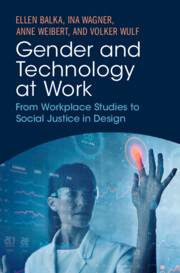Book contents
- Gender and Technology at Work
- Gender and Technology at Work
- Copyright page
- Contents
- Preface
- 0 Introduction
- Part I Gender and Technology
- Part II Gender and Technology at the Workplace
- 4 Women and Machines in the Factory
- 5 Office Automation and the Redesign of Work
- 6 Beyond the Office
- 7 AI-Based Technologies
- 8 The Computerization of Care Work
- 9 The Gendering of Computer Work
- Part III Gender and Design
- Postscript
- References
- Index
5 - Office Automation and the Redesign of Work
from Part II - Gender and Technology at the Workplace
Published online by Cambridge University Press: 28 March 2024
- Gender and Technology at Work
- Gender and Technology at Work
- Copyright page
- Contents
- Preface
- 0 Introduction
- Part I Gender and Technology
- Part II Gender and Technology at the Workplace
- 4 Women and Machines in the Factory
- 5 Office Automation and the Redesign of Work
- 6 Beyond the Office
- 7 AI-Based Technologies
- 8 The Computerization of Care Work
- 9 The Gendering of Computer Work
- Part III Gender and Design
- Postscript
- References
- Index
Summary
This chapter discusses the computerization of office work, which in many ways served as a focal point for the emergence of research about gender and technology in the 1980s. The focus on office automation allows us to explore topics that have been central to the development of feminist perspectives on work. The issues the chapter addresses include the nature of office work, invisible work and skill, the ‘gendering’ of office machines, and debates about skill – deskilling, upskilling, and the social construction of skill. Observational studies of office information also produced many valuable insights concerning technology, organization, and managerial decisions, with a focus on skill, learning, and the need for workplace design aiming to support office workers to appropriate the new technologies integrating them into their practices. The chapter positions workplace design with respect to several strong traditions of (re)designing jobs and the organization in which they are embedded that were developed in the 1970s and 1980s.
- Type
- Chapter
- Information
- Gender and Technology at WorkFrom Workplace Studies to Social Justice in Design, pp. 133 - 154Publisher: Cambridge University PressPrint publication year: 2024



